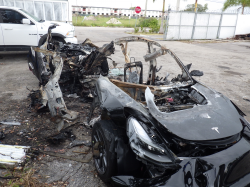
— A Tesla Coral Gables crash that killed two people has led to the family of the driver suing Tesla for wrongful death and for building and selling an allegedly defective Model 3.
According to the Tesla Model 3 lawsuit, Nicholas G. Garcia, 20, was driving the car on September 13, 2021, with 19-year-old passenger Jazmin G. Alcala.
The lawsuit alleges as Garcia was driving on Alhambra Circle in Miami-Dade County, Florida, the Model 3 crossed an intersection as the suspension failed and the bottom of the car hit the road.
The lawsuit also says the batteries ignited and sparks shot out from the Model 3 as it veered off the road, hit trees and burst into flames, killing both Model 3 occupants.
The wrongful death lawsuit faults Tesla for failing to safely design the Model 3 and its components so the suspension, body, wheels and frame do not fail "during ordinary and foreseeable driving conditions."
And according to the Tesla lawsuit, a service manager is also at fault because he should have warned Mr. Garcia the Model 3 was allegedly defective from the time it was manufactured.
On September 9, 2021, Mr. Garcia allegedly brought the Model 3 to a Tesla store because of problems which included the battery, electronic system, suspension, steering and doors.
The Tesla Model 3 was inspected and serviced, but the lawsuit asserts the service manager, "knew, or, in the exercise of reasonable care, should have known, that the Subject Vehicle was not properly designed, manufactured, assembled, tested, inspected, and sold, and knew, or, in the exercise of reasonable care, should have known, that the Subject Vehicle, and its components, created an unreasonable risk of harm to persons, like the Decedent, Nicholas G. Garcia."
The plaintiffs who sued also claim Tesla failed to design the Model 3 and its components to adequately protect from a loss of control, "during ordinary and foreseeable driving conditions."
National Transportation Safety Board Investigation
Because the fatal crash occurred in an electric car and involved a battery fire, the National Transportation Safety Board (NTSB) opened a formal investigation into the Tesla Coral Gables crash.
Investigators collected information from the Tesla Model 3 event data recorder and learned that within five seconds of the crash, the car was traveling 90 mph as Garcia tried to beat a yellow light on a residential street with a posted 30 mph speed limit.
The NTSB also determined the driver never applied the brake pedal.
As it traveled through the intersection, the Model 3 hit a hump in the road at high speed which caused a violent bounce of the car as sparks shot from the bottom of the car from the impact with the road.
According to the NTSB, the Model 3 slammed into a tree which rotated the car and sent it into another tree, causing the Tesla to burst into flames.
The NTSB has not released its final report about the fatal Tesla Model 3 crash, but you can watch video of the crash below.
The Tesla Coral Gables crash lawsuit was filed in the 17th Judicial Circuit Court of Broward County Florida: Mirta Garcia, v. Tesla, Inc., et al.
The plaintiffs are represented by Davis Goldman, PLLC.
Tesla Coral Gables Crash Video




